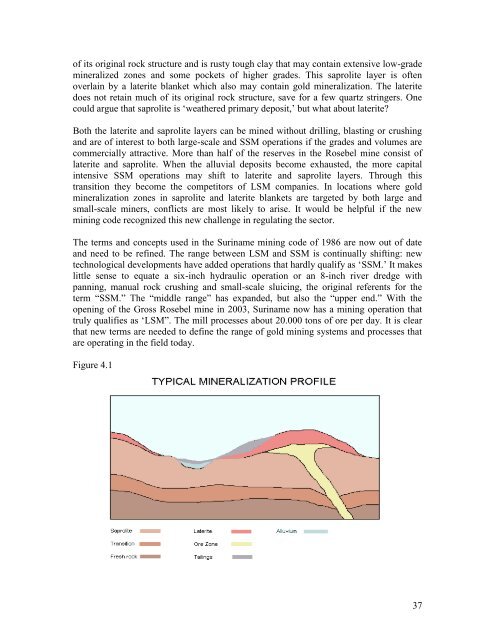SITUATION ANALYSIS OF THE SMALL-SCALE GOLD ... - WWF
SITUATION ANALYSIS OF THE SMALL-SCALE GOLD ... - WWF
SITUATION ANALYSIS OF THE SMALL-SCALE GOLD ... - WWF
You also want an ePaper? Increase the reach of your titles
YUMPU automatically turns print PDFs into web optimized ePapers that Google loves.
of its original rock structure and is rusty tough clay that may contain extensive low-grade<br />
mineralized zones and some pockets of higher grades. This saprolite layer is often<br />
overlain by a laterite blanket which also may contain gold mineralization. The laterite<br />
does not retain much of its original rock structure, save for a few quartz stringers. One<br />
could argue that saprolite is „weathered primary deposit,‟ but what about laterite?<br />
Both the laterite and saprolite layers can be mined without drilling, blasting or crushing<br />
and are of interest to both large-scale and SSM operations if the grades and volumes are<br />
commercially attractive. More than half of the reserves in the Rosebel mine consist of<br />
laterite and saprolite. When the alluvial deposits become exhausted, the more capital<br />
intensive SSM operations may shift to laterite and saprolite layers. Through this<br />
transition they become the competitors of LSM companies. In locations where gold<br />
mineralization zones in saprolite and laterite blankets are targeted by both large and<br />
small-scale miners, conflicts are most likely to arise. It would be helpful if the new<br />
mining code recognized this new challenge in regulating the sector.<br />
The terms and concepts used in the Suriname mining code of 1986 are now out of date<br />
and need to be refined. The range between LSM and SSM is continually shifting: new<br />
technological developments have added operations that hardly qualify as „SSM.‟ It makes<br />
little sense to equate a six-inch hydraulic operation or an 8-inch river dredge with<br />
panning, manual rock crushing and small-scale sluicing, the original referents for the<br />
term “SSM.” The “middle range” has expanded, but also the “upper end.” With the<br />
opening of the Gross Rosebel mine in 2003, Suriname now has a mining operation that<br />
truly qualifies as „LSM”. The mill processes about 20.000 tons of ore per day. It is clear<br />
that new terms are needed to define the range of gold mining systems and processes that<br />
are operating in the field today.<br />
Figure 4.1<br />
37
















